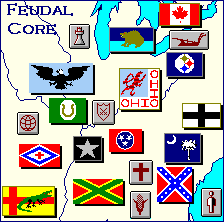
The Feudal Core is an interesting region of the map. Unlike many of the other sections, this isn't necessarily categorized by geography, so much as the social structure (Although it's also called "The Heartland" in many files". Pretty much all the nations in this area are governed in a feudal society, with 14 of the twenty major feudal kingdoms. It's also, in many ways, the core of America in general. It's mostly eastward, but moving somewhat towards the middle, and as many as 28 million (nearly half the population) live there. This is no longer flyover country, but where most of the action is.
White has touched very little on what it's like here. Most of what we know about the Feudal Core is what contrasts it, like the Horse Archers. We do know what their religion is like, as they, like the United States of America, are strict practitioners of Non-Denominationalism . We know almost a third of them are distinctly part of the Southern culture. Everything else is pure conjecture. From the trade map, we can see it's very much agrarian, gradually going from cotton, to tobacco, to grain in the northern regions. And we know that the, along with its feudal overlords, it tends to favor knights, except for some of the newly conquered frontiers and sparsely-populated mountains. What we do know about the feudal states in America is that a great many of them share names of rivers, and that the leaders, despite being feudal warlords, don't want to take the outright monarch terms like "King" or "Prince" but take on titles like "President", "Governor" and "Colonel".
Iowa is the only feudal core nation mentioned, and perhaps betraying White's fascination with the herdsmen, and seems to have a pretty distinct parallel--barbarian tribes that eventually went native, like the Saxons, Vikings, and Magyars.
Ohio seems to have absorbed Indiana and Kentucky, and may be the central power of the Heartland, perhaps even the entire continent. Inside its borders you have three important trade cities, six, maybe even seven million residents, and as many as four district headquarters for the Church. The Iowa page shows that it did a decent job of defending itself from barbarian invasion. The Ohio river allows it to be a major pathway of commerce (and the occasional river barges), and the vast amounts of grain it produces means massive amounts of armies. What likely keeps it from becoming completely dominant is that it's still a little landlocked.
Below Ohio is the much less stable area of Tennessee. This is may be the most balkanized region of the continent, and "Balkan" may be the operative word here. The state's "three grand divisions" have been accentuated, between the hot cotton country of the west, the "capital district" (and thus, possible ecclesiastical fiefdom) of the middle, the Appalachian, possibly highlander-inspired West. However, the most western flag is a green flag with a horseshoe mark This may be Missouri as Iowa's page seems to say Shelby had a hand in rebuilding St Louis, so the area as a whole may generally be considered a colony of patronage of Tennessee, hence its classification in the area.
Piedmont is an interesting case study. It appears to be the only area in the core to have access, to the Atlantic although the US's presence, and very swampy east coast has kept them from building there too much, and they pretty much stick to the fertile valleys. During the Revolutionary War, it was the epicenter of Loyalists. In the Industrial Age, it was the model of the New South, and a growing source of votes for the Democratic Party. In Medieval America, it's very physically close the mercantile Republics. One can imagine a very courtly, cosmopolitan atmosphere. In fact, the warfare map shows it's not a war zone at all. Thus, Piedmont is probably the most picturesque, almost Fairy Tale-like place on the whole continent.
The Deep South comes next. it's symbolized by two flags, both with crosses. One is Georgia's flag, and more or less the symbol for the Confederate States, and Southern Pride in general. Though the url says "Dixie", the Southern lifestyle page is called "Deep South" on the front page, and thus everything White talks about is most exemplified in this section, and this might have been the last "nation" page to have been written, if ever. The area includes Georgia, Alabama and Mississippi, more or less, forged into two large nations and a smattering of smaller ones. I would guess nobody cheered louder when civilization fell, as the South was finally able to call their own shots and draw on their own history. With its warrior culture, scantily clad population, and plantation manors made out of marble, we're probably looking at an aesthetic not unlike the movie 300, but with more confederate flags. Which for many fans, may be the only way one can improve the movie 300.
Finally there's the Southern Frontier. Or it may simply be the Southern Front. The two flags we see is Arkansas's flag with a cross, and another is the flag of St. Magnus, with an alligator on top of it. This leads me to believe that we're dealing with buffer/crusader states, that are bulwarks of of a cultural triangle between Non-Denominationalism, New Israel, and Voodoo. The alligator flag belongs to Red River, which seems to be a hodgepodge of Arkansas, Texas and Louisiana. Note that it's the largest kingdom without a District HQ in it, which probably truly means it's considered a frontier, and may be a real mix of different cultures, much like the Levant in the old Middle Ages.

Next stop, FLORIDA!
ReplyDelete